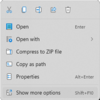Hi folks
Any of you guys who still have old Technet keys - W10/W11 activated with a digital license -- STILL -- I needed a New VM on totally new hardware and it activated with digital license.
1) Just at Install time --DO NOT ENTER A PRODUCT KEY -- choose I don't have a product key.
2) After boot up go to activation ->change product key
3) enter the old technet key
Q.E.D -- active -- those old technet keys are valid for zillionsof activations BTW !!!!
Cheers
jimbo
Any of you guys who still have old Technet keys - W10/W11 activated with a digital license -- STILL -- I needed a New VM on totally new hardware and it activated with digital license.
1) Just at Install time --DO NOT ENTER A PRODUCT KEY -- choose I don't have a product key.
2) After boot up go to activation ->change product key
3) enter the old technet key
Q.E.D -- active -- those old technet keys are valid for zillionsof activations BTW !!!!
Cheers
jimbo
My Computer
System One
-
- OS
- Windows XP,7,10,11 Linux Arch Linux
- Computer type
- PC/Desktop
- CPU
- 2 X Intel i7

















